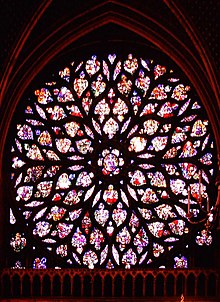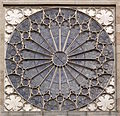Rose window

As a rose window (also simply: rose ), window rose (also simply: rosette ) or rose window , a circular glazed window with tracery infills is referred to in architecture . Rose windows can be found mainly on Gothic churches; however, there are older models.
Demarcation
If columns or profiles are arranged around a central point or ring on the rosette, like on a spoked wheel, it is called a wheel window or Katharinenrad (after Saint Catherine ). Wheel windows are already known in the Romanesque period , such as the "wheels of fortune" at Basel Minster or at the St-Étienne church in Beauvais , which symbolize the changeability or moodiness of earthly happiness. A circular or oval window opening without any filling, on the other hand, is called " ox eye " or "oculus". Many Gothic rose windows orientate themselves clearly and for a long time to the basic principles of the wheel windows, from which they are clearly separated only in the flamboyant roses of the late Gothic .
placement
Tracery roses with some very large dimensions of over 13 m in diameter were created in the Gothic era. They are usually installed centrally above the main entrance on the west side or in the transept facades and can even take up the entire width of the facade, such as the transepts of the cathedral Notre-Dame de Paris or the cathedral of Chartres .
symbolism
The central position of the rose window has a strong, suggestive and meditative effect. It looks extremely magnificent (especially when colored glass is used), powerful, beautiful, calming and harmonious. Due to its ideal circular shape, it repeatedly encourages symbolic interpretations. She can embody the perfection of the love of the divine that spreads in all directions. The elaborate architectural structure of the rose often plays with elements of number and circle symbolism in order to make the omnipresence of God in the world or the life cycle tangible. The radial radiance of the tracery tracks is reminiscent of the sun and prompts further interpretations here as well. This arrangement gave the name to the French stylistic term for the high Gothic, " rayonnant " (that is, radiant, French rayon = ray).
photos
Romanesque wheel window from Santo Domingo in Soria (Spain)
Romanesque "wheel of fortune" at Basel Minster
Rose in the Ebrach Monastery in Bavaria, exterior view
Gothic rose in Notre-Dame Cathedral in Paris
South side of the Notre-Dame with the exterior view of the rose shown on the left
Rose of the in Florence Cathedral
Rose of the Strasbourg Cathedral , with a diameter of 13.6 meters one of the largest in Europe
Rose on the east side of La Seu Cathedral in Palma de Mallorca
See also
literature
- Ellen Judith Beer : The rose of the cathedral of Lausanne and the cosmological circle of images of the Middle Ages (= Berner Schriften zur Kunst , Volume 6 ZDB -ID 519240-7 ) Benteli, Bern 1952, DNB 450303047 (dissertation University of Bern, Faculty of Philosophy and History 1952, 80 pages).
- Ellen Judith Beer: The stained glass in Switzerland from the 12th to the beginning of the 14th century , published under the patronage of the Swiss Humanities Society and the Society for Swiss Art History by Hans R. Hahnloser, (= Corpus Vitrearum Medii Aevi , Switzerland , Volume 1 ). Birkhäuser, Basel 1956, DNB 450303020 .
- Painton Cowen: The Rose Windows of the Gothic Cathedrals. 3. Edition. Herder, Freiburg im Breisgau 1990 (original title: Rose Windows , translated by Ingeborg Schmid), ISBN 3-451-21876-3 .
- Painton Cowen: Gothic splendor: the rose windows of the great cathedrals (original title: The Rose Windows , translated by Wolfdietrich Müller), Belser, Stuttgart 2015, ISBN 978-3-7630-2707-1 .
- Helen J. Dow: The Rose Window. In: Journal of the Warburg and Courtauld Institutes. 20, 1957, ISSN 0083-7180 , pp. 248-297.
- Friedrich Kobler: Rose window In: Reallexikon zur Deutschen Kunstgeschichte . Volume 8: Rose window - varnish . Munich 1982, Sp. 65–203, ISBN 3-406-14197-8 .
- Wiltrud Mersmann : Rose window and heavenly circles. Mäander, Mittenwald 1982, ISBN 3-88219-195-3 .
- Theodore Rieger: Roses romanes et roses gothiques dans l'architecture religieuse alsacienne. In: Cahiers alsaciens d'archéologie, d'art et d'histoire. 22, 1979, ISSN 0575-0385 , pp. 67-105.
- Robert Suckale : Theses on the change in meaning of the Gothic rose window. In: Karl Clausberg , Dieter Kimpel et al. (Ed.): Buildings and images in the high Middle Ages. Illustrative contributions to cultural and social history (= art studies by the Ulmer Verein , Association for Art and Cultural Studies, Volume 11). Anabas, Giessen 1981, ISBN 3-87038-082-9 , pp. 259-294.
- Matthias Vollmer: Fortuna diagrammatica: the wheel of Fortuna as a graphic encoding of the text "De consolatione philosophiae" by Boethius (= Apeliotes , Volume 3), Lang, Frankfurt am Main / Berlin /; Bern / Bruxelles / New York, NY / Oxford / Vienna 2009, ISBN 978-3-631-57949-7 (Dissertation FU Berlin 2007, 309 pages),
Web links
- Article window rose in the art dictionary by PWHartmann
- Gallery of the wheel and rose windows at www.kathedralen.net











